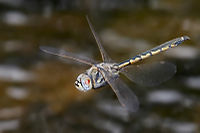
Photo from wikipedia
Abstract This study explores the effects of wing flexibility on several characteristics of flight, in this case the trim conditions, power requirements and dynamic stability of an insect-like flapping-wing micro-air… Click to show full abstract
Abstract This study explores the effects of wing flexibility on several characteristics of flight, in this case the trim conditions, power requirements and dynamic stability of an insect-like flapping-wing micro-air vehicle (FWMAV) based on the hawkmoth Manduca sexta. The wing structure is analyzed by the finite-element method. A potential-based aerodynamic model which encompasses the unsteady panel method and the extended unsteady vortex-lattice method is employed to compute the aerodynamic forces. The motions of the FWMAV are obtained using a flexible multibody dynamics program coupled with the potential-based aerodynamic model. The results of this study show that the trim conditions of insect-like flexible and rigid FWMAVs may differ significantly from each other. When the flight speed is less than 3.0 m/s, using flexible wings is favorable, as they help the FWMAV reduce the power requirement and stabilize the lateral dynamics. However, at 3.0 m/s, these advantages are almost unnoticeable, while at 4.0 m/s, the flexible insect-like FWMAV requires even more mechanical power than its rigid counterpart.
Journal Title: Aerospace Science and Technology
Year Published: 2018
Link to full text (if available)
Share on Social Media: Sign Up to like & get
recommendations!